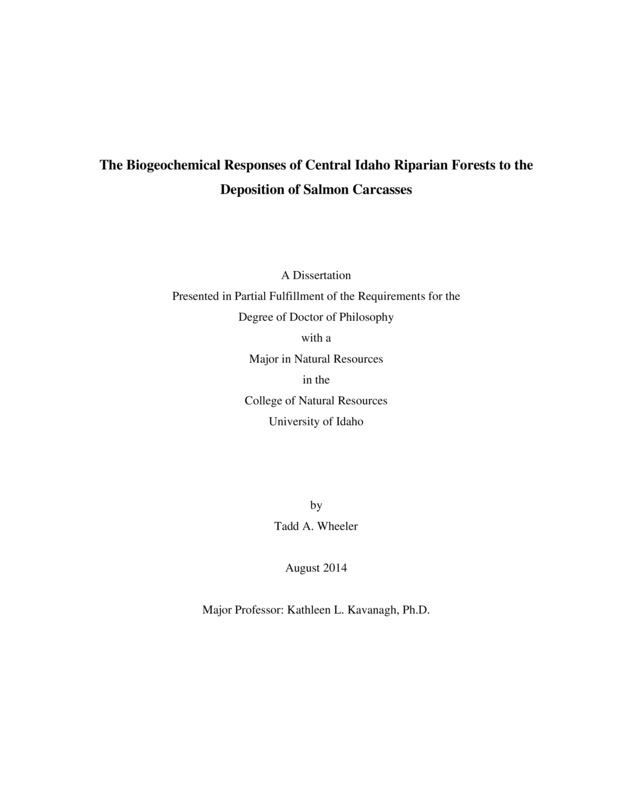The biogeochemical responses of central Idaho riparian forests to the deposition of anadromous fish carcasses
Wheeler, Tadd. (2014). The biogeochemical responses of central Idaho riparian forests to the deposition of anadromous fish carcasses. Theses and Dissertations Collection, University of Idaho Library Digital Collections. https://www.lib.uidaho.edu/digital/etd/items/wheeler_idaho_0089e_10410.html
- Title:
- The biogeochemical responses of central Idaho riparian forests to the deposition of anadromous fish carcasses
- Author:
- Wheeler, Tadd
- Date:
- 2014
- Keywords:
- Anadromous fish Isotopic enrichment Marine Derived Nutrients Riparian Salmon Nutrients Soil Nitrogen
- Program:
- Natural Resources
- Subject Category:
- Natural resource management; Forestry; Fisheries and aquatic sciences
- Abstract:
-
Pacific salmonids are thought to provide a vital nutrient link between the ocean and their natal streams. However, most of what is known about the ecologic role of salmonids in their natal ecosystems is derived from coastal maritime investigations. Appropriately mitigating for the decline of returning salmonids to inland ecosystems requires understanding the biogeochemical responses of these ecosystems to the deposition of salmon born nutrients, particularly within riparian ecosystems where the semi-arid climatic conditions of this region may have the greatest influence on these biogeochemical responses.
The terrestrial decomposition of salmon carcasses and the subsequent release of carbon and nitrogen in an inland semi-arid environment as well as the influences of freezing and heat treating salmon carcasses for disease mitigation was evaluated. Decomposition proceeded rapidly in this semi-arid climate overriding any overall influences of the disease mitigation methods on decomposition time or soil carbon and nitrogen accumulation. A notable finding was a 4 / ä15N enrichment of the carcass fluids entering the soil, relative to whole carcasses. This alteration of isotopic ratios has direct implications on isotopic mixing model estimates of soil and vegetative marine derived nutrient composition.
The soil biogeochemical responses to the deposition of anadromous fish carcasses in riparian forests of central Idaho were investigated and the soil loading of carbon and nitrogen per fish carcass estimated. This investigation revealed dramatic increases in soil carbon and nitrogen chemistry that far exceeded and persisted longer than reported responses in coastal ecosystems. However, the carbon and nitrogen loading estimates were only able to account for a small portion of the carbon and nitrogen in the fish carcasses.
The annual and inter-annual responses of riparian vegetation to the deposition of anadromous fish carcasses in riparian forests of central Idaho was investigated. The investigation revealed that herbaceous species can quickly utilize carcass nutrient subsidies but that the nutrients are depleted within two to three years. Conifer seedlings appear to have a much higher resource acquisition and storage capacity as foliage produced three years after carcass nutrient additions contained large quantities of marine derived nitrogen.
- Description:
- doctoral, Ph.D., Natural Resources -- University of Idaho - College of Graduate Studies, 2014
- Major Professor:
- Kavanagh, Kathleen
- Committee:
- Coleman, Mark; Johnson-Maynard, Jodi; Fremier, Alex
- Defense Date:
- 2014
- Identifier:
- Wheeler_idaho_0089E_10410
- Type:
- Text
- Format Original:
- Format:
- application/pdf
- Rights:
- In Copyright - Educational Use Permitted. For more information, please contact University of Idaho Library Special Collections and Archives Department at libspec@uidaho.edu.
- Standardized Rights:
- http://rightsstatements.org/vocab/InC-EDU/1.0/

